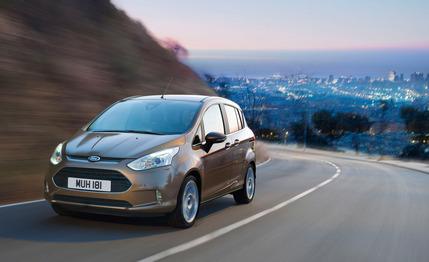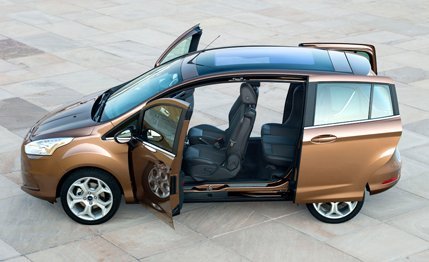 First Drive Review
First Drive Review
Losing the B-pillar has long been the stuff of designers’ dreams—just look at all of the concept cars presenting an uninterrupted view of the interior, promising space, style, and easy access. But in the real world, doing away with the structural element at the center of a car is problematic, not least because of crash-protection concerns.
So it was with surprise and even disbelief that Martin Smith, head designer for Ford of Europe, received a request from chief program engineer Klaus-Peter Tamm to eliminate the center pillars on the new Fiesta-based B-Max micro-minivan.
Wide-Open Spaces
Research carried out by Ford’s advanced engineering group in Dunton, England, had concluded that the primary requirement from a car of this type was easy access for people and luggage. That suggested sliding rear doors—and the absence of those pesky side pillars. Tamm was prepared to accept the extra weight, cost, and complexity this would involve, but not the boxy appearance of a van.
The result is a stylish five-door hatchback that looks like a cross between a pumped-up Fiesta and a tall Focus hatch. At 160.5 inches long and built on the same 98.0-inch wheelbase as the Fiesta, it doesn’t really fit into any established market sector, but it has a unique selling proposition: an unrivalled 59-inch-wide clear space between the open doors.

In the downsizing European market, that could be a winning feature. The door arrangement makes it easier for people of all ages and varying mobility to get in and out, while the rear seats and the front passenger seat fold flat so that objects up to 90 inches long can be accommodated. Bicycles and other bulky kit can enter through the side opening, too.
Ford engineers talk about how the B-pillar wasn’t so much eliminated but instead has been incorporated into the doors. Judicious use of high-strength steel has produced a body structure with higher torsional stiffness than a Fiesta hatchback. A ring of ultra-high-strength boron steel forms the door openings, while the door frames are reinforced and work together to absorb crash energy. A sturdy latch mechanism locates the doors top and bottom and is supplemented by special “crash catchers,” which lock the doors together in a side impact. Ford is confident of a top, five-star rating in Euro-NCAP crash tests.
Van owners know that sliding doors are a regular source of squeaks and rattles, that they can be stiff and awkward to operate, and they rarely shut with the gentle clunk befitting a premium car. The B-Max isn’t a premium car, although it is positioned higher in the market than the Fiesta on which it is based. But neither is it a passenger version of a utility vehicle. The top-spec Titanium models we drove in southern Germany are priced right in the middle of the Focus range, and they match the bigger car in refinement and trim quality. Of course, they were fresh from the factory in Craiova, Romania, but we noted that wind and road noise were low and the doors operated with a pleasing precision.